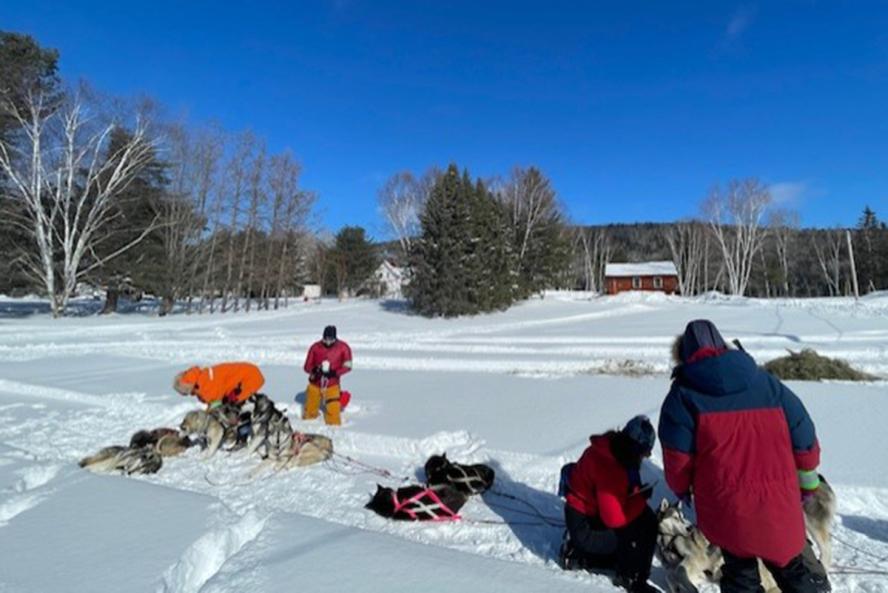“We’re there for the mushers and the dogs. The goal is to make sure they have a happy, healthy race so that the dogs and mushers get to keep doing what they love,” says Pope.
The veterinary teams are outfitted in bright green armbands and lights, making them easily recognizable to the mushers and handlers. Pope and Santasieri’s team donned matching green leis and nicknamed their checkpoint the Allagash Aloha Station.
“I’m not sure how we landed such a cushy gig. Between shifts, you get to hang out in the diner and eat delicious food. It’s a really fun outpost,” says Santasieri.
Berger was stationed in a wilderness checkpoint set up in a logging station garage along the 250-mile trail. Eight Canadian and American teams passed through over her three days there.
“The teams come into our checkpoint at any hour of the day,” says Berger. “It’s exciting to see them come in. At night, you’ll see this whole set of eyes coming through the woods, and it’s silent unless a musher is giving them directions or encouragement.”
Berger hails from the large animal veterinary realm, a clinician with Tuft Veterinary Field Service (TVFS). She has specialized training with horses and also treats small ruminants, camelids, and occasionally pigs and cattle, traveling with TVFS to see animals on the farm or in the field.
“We are used to treating animals regardless of the environment. I didn’t expect evaluating animals at a trail stop to translate so well. I was surprised how much was applicable between large animal medicine and sled dog medicine,” says Berger.
With race temperatures dipping as low as negative 20 degrees Fahrenheit, Berger is familiar with treating patients in cold weather, such as how to administer fluids in the field without freezing and in the dark, often working by headlamps or truck lights. Her background in equine lameness helped her pick up on musculoskeletal issues in the sled dogs.
Previously on the Emergency Medicine and Critical Care (ECC) team and later the hemodialysis unit at FHSA, Santasieri now manages the Kelley Simulation Lab and teaches Clinical Skills labs. He also works with Nero’s Law Training Project, managing equipment for police dog trainers throughout Massachusetts. His work with sled dogs sparked an interest in working dog and athlete medicine. He recently presented on trauma and emergency first aid on the trail at a sport dog trade fair.
Before joining the oncology service at FHSA, Pope worked in emergency medicine. “This is my once-a-year foray back into ECC,” she says.
Similarly, the pool of veterinary team volunteers represents a broad spectrum of fields—from general practice to niche specialties—some local and some from as far as Texas.
“The diversity on our team allows us to better care for the dogs,” says Santasieri. “There’s this culture on the veterinary team of sharing knowledge. If it looks like a dog’s gait is slightly different, we call the rest of the team over. It’s a fun, educational experience for all of us.”
While the Can-Am Crown was canceled last year due to insufficient snowfall, this year, the teams raced through tons of fresh powder. “Dogs were breaking trail, so it’s a lot more strenuous,” says Berger.
The most common ailments were sore paws and shoulders from all the snow. Dogs remain at a checkpoint if they’re not in a condition to continue, are overly tired, or if mushers strategically drop them. Each team starts with 12 dogs, and mushers can drop up to three dogs for injury or if they’re slowing down the team.
On top of the excitement of the racing, the fellowship among the veterinary team, mushers, and the local community is palpable.
“The mushers were great to work with, especially to see the camaraderie of the U.S. and Canadian teams together,” says Berger. “How much the mushers really value the welfare of the dogs over everything else really stood out for me.”
Santasieri echoes Berger’s sentiments, “Mushers are so tuned in with their dogs. They know every tiny detail about their dogs and notice any changes that occur. They’re always calling us over to take a look at something or ask our opinion. The bond they have with their dogs is absolutely incredible.”
The races and spirit of volunteerism are deeply embedded into the Fort Kent community. People from the town donate food to all the veterinary checkpoints. A local cook prepared meals around the clock at Berger’s station. After the races ended, residents invited the entire veterinary team for dinner at their home.
“The sense of community is always amazing and impressive to me. Almost every resident of the area has something to do with the races,” says Pope.
The last team to cross the Can-Am Crown finish line receives a red lantern, symbolizing that the lights are kept on for the mushers and dogs until the very end—with Cummings School’s crew among those light-bearers.
